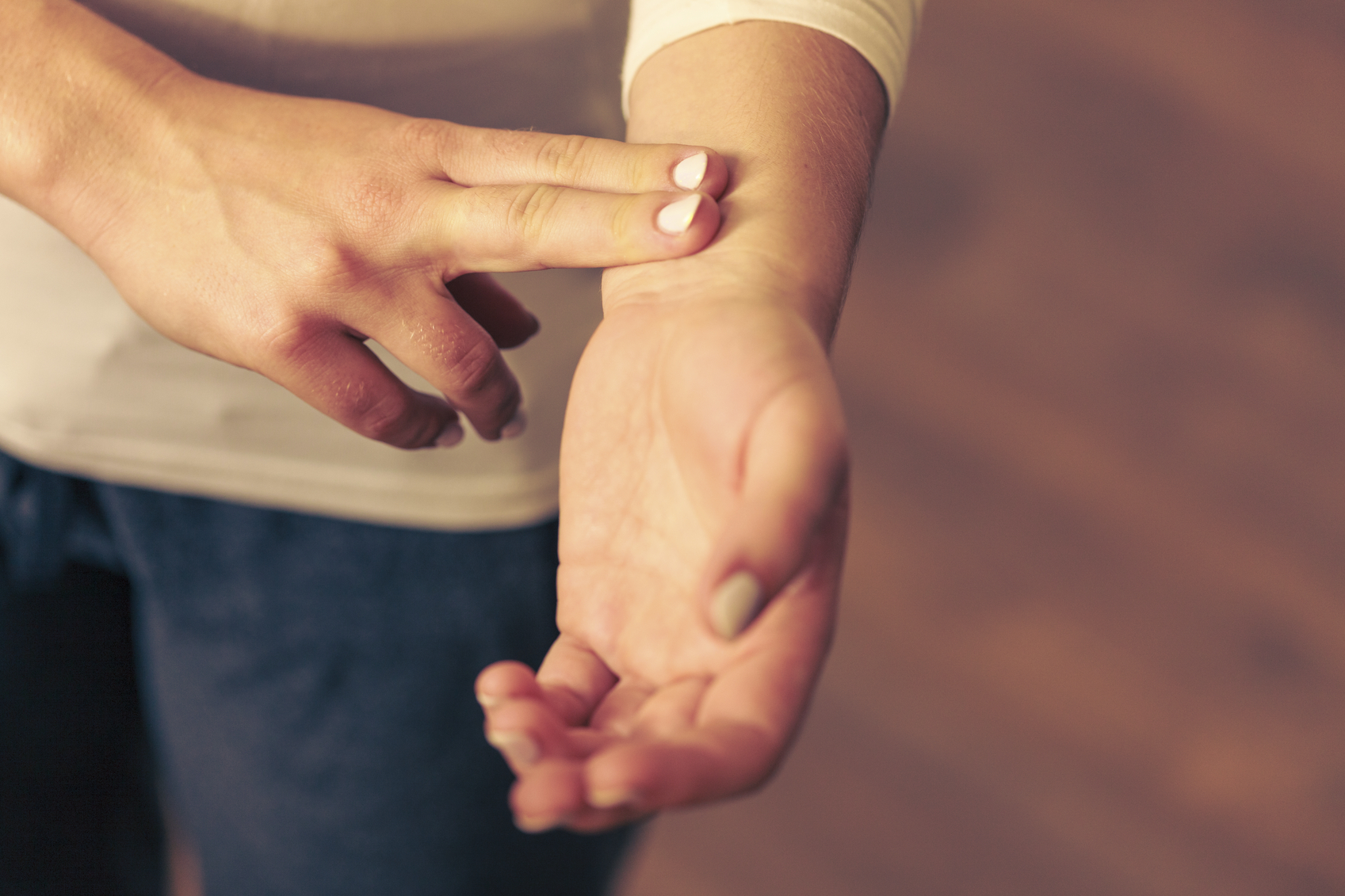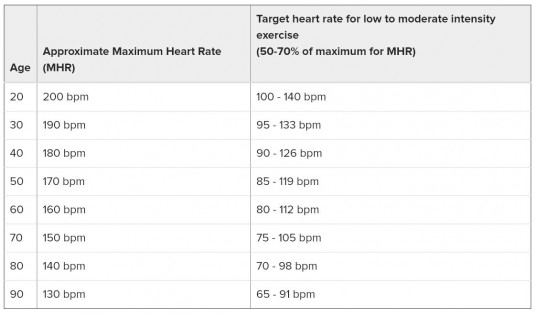You can check your heart rate by taking your pulse and counting how many times your heart beats in a minute.
Your heart rate varies depending on what you're doing – for example, it will be slower if you're sleeping and faster if you're exercising.
To get your resting heart rate, you need to have been resting for at least 5 minutes before checking your pulse.
Finding your pulse
You can find your pulse in your wrist or neck.
- A normal resting heart rate for adults ranges from 60 to 100 beats per minute. Generally, a lower heart rate at rest implies more efficient heart function and better cardiovascular fitness. For example, a well-trained athlete might have a normal resting heart rate closer to 40 beats per minute. To measure your heart rate, simply check your pulse.
- Most adults have a resting heart rate between 60 and 100bpm. The fitter you are, the lower your resting heart rate is likely to be. For example, athletes may have a resting heart rate of 40 to 60bpm, or lower. See a GP to get checked if you think your heart rate is continuously above 120bpm or below 40bpm, although it may simply be that this is normal for you.
To find your pulse in your wrist:
Normal Resting Pulse Adult
Your pulse rate is the number of times your heart beats per minute. A normal resting heart rate should be 60–100 beats per minute, but it can vary from minute to minute. It can go up to 130–150 beats or higher per minute when you’re exercising – that’s normal because the body needs to pump more oxygen-rich blood around the body. A pulse oximeter to check your oxygen saturation level and your heart rate at home.
- hold out one of your hands, with your palm facing upwards
- press the first (index) finger and middle finger of your other hand on the inside of your wrist, at the base of your thumb – don't use your thumb as it has its own pulse
- press your skin lightly until you can feel your pulse – if you can't find it, try pressing a little harder or move your fingers around
To find your pulse in your neck:
- press your first finger and middle finger to the side of your neck, just under your jaw and beside your windpipe – don't use your thumb
- press your skin lightly to feel your pulse – if you can't find it, try pressing a bit harder or move your fingers around
Checking your pulse
When you find your pulse, either:
- count the number of beats you feel for 60 seconds
- count the number for 30 seconds and multiply by 2

This gives you your heart rate – the number of times your heart beats per minute (bpm).
You can also check if your pulse is regular or irregular by feeling its rhythm for about 30 seconds. It's very common to have occasional irregular heartbeats, such as missed beats.
But if your pulse continues to be irregular, it can be a sign of atrial fibrillation – an irregular and often abnormally fast heart rate. This is more likely if you're 65 or older.


See a GP if you're worried about your pulse.
What's a normal heart rate?
Most adults have a resting heart rate between 60 and 100bpm.
The fitter you are, the lower your resting heart rate is likely to be. For example, athletes may have a resting heart rate of 40 to 60bpm, or lower.
See a GP to get checked if you think your heart rate is continuously above 120bpm or below 40bpm, although it may simply be that this is normal for you.
Visit the British Heart Foundation for more information on checking your pulse.
Exercise and your pulse
If you check your pulse during or immediately after exercise, it may give an indication of your fitness level. A heart rate monitor is also useful for recording your heart rate when resting and during exercise.
Aerobic activities such as walking, running and swimming are good types of exercise because they increase your heart and breathing rates.
Read more from the British Heart Foundation on what your heart rate should be while exercising (PDF, 200kb).
If you haven't exercised before, or haven't for some time, see our Live Well section to read about the benefits of exercise and how much exercise you should be doing.
Further information:
Page last reviewed: 22 February 2018
Next review due: 22 February 2021
The heart is an organ located just behind and slightly to the left of the breastbone, and pumps blood through a network of veins and arteries known as the circulatory system. The right atrium is sent blood from the veins, and delivers it to the right ventricle. It's then pumped into the lungs where it is oxygenated. The left atrium is sent oxygen enriched blood from the lungs and delivers it to the left ventricle, where it's then pumped throughout the body, and the ventricular contractions create blood pressure.
A pulse is the beating of the heart as it's felt through the walls of an artery, such as the radial artery at the wrist. Pulse rates can also be felt and measured at the carotid artery located on the side of the neck, the temporal artery at the temple, or the femoral artery on the anterior side of the hip, and a chart showing normal heart rate can be used to check on your heart rate.
A resting heart rate is defined as a pulse that is taken when you are calm, sitting or lying down, and the best time to measure a resting heart rate is in the morning before you leave the bed. Generally speaking, a lower heart rate functions more effectively and efficiently.
How to Take Your Heart Rate
Check your own pulse by placing the tips of your first three fingers lightly on the inside of your wrist below your thumb. You can also check your pulse by placing two fingers on your neck beside the windpipe. You may have to feel around until you feel the pulse beneath your fingers. Once you feel a pulse, use the second hand of a watch or clock to time 10 seconds while simultaneously counting your heart beats. Then multiply the number of heartbeats by 6 to get your heart rate per minute, or number of beats = ______ x 6 = ______beats/min.
Then compare it to the normal heart rate chart below:
Age (years) | Heart Rate (beats/min) |
Less than 1 | 100 to 160 |
1 to 2 | 90 to 150 |
2 to 5 | 80 to 140 |
6 to 12 | 70 to 120 |
Greater than 12 | 60 to 100 |
Well-Trained Athletes | 40 to 60 |
Normal Resting Pulse Ox
Chart. 1
Chart. 2
Factors That May Affect Your Heart Rate
Normally, your heart rate should have a strong steady rhythm. However, various factors may affect your heart rate and make it different to the ranges in the normal heart rate chart above. You can seek the advice of your health care provider for any health conditions you may have that can affect your pulse. Conditions may include:
Fast Pulse:
- Exercise or activity
- Medication
- Illness or fever
- Anemia
- Heart disease
- Stimulants such as amphetamines, diet pills, caffeine, and tobacco
- Alcohol consumption
- An overactive thyroid
- Stress
Slow Pulse:
- High levels of fitness
- Heart disease and medication for treatment
- Hypothyroidism (underactive thyroid gland)
- Body is at rest
Weak Pulse:
- Peripheral arterial disease (diseases of the blood vessels)
- Chronic heart disease/failure
- Possible blood clot
Your maximum heart rate is the highest heart rate that is achieved during strenuous exercise. One method to calculate your approximate maximum heart rate is the formula: 220 - (your age) = approximate maximum heart rate. For example, a 30 year old's approximate maximum heart rate is 220 - 30 = 190 beats/min.
Target heart rate: You can maximize the benefits and reduce the risks when you are exercising within your target heart rate zone. Your target heart rate when exercising is normally 60 to 80 percent of your maximum heart rate. This may be increased or decreased depending on your health factors, and your health care provider may want you to limit the target heart rate zone to 50 percent. However, it is not recommended to exceed 85 percent of your maximum heart rate. Anything above 85 percent increase risks to the orthopedic and cardiovascular system, with minimal added benefits from the exercise.
Normal Resting Pulse Rate Chart By Age
Normal Maximum and Target Heart Rate Chart
Besides a normal heart rate chart when resting, there're also normal ranges for heart rate during exercising. The following table shows the approximate target heart rates for various age groups.Find the age group closest to your age and find your target heart rate. The guidelines for moderately intense activities is about 50-69% of your maximum heart rate, and hard physical activity is about 70% to less than 90% of the maximum heart rate.
Age | Maximum Heart Rate (beats/min) | Target Heart Rate (beats/min) |
20 | 200 | 100 to 170 |
30 | 190 | 95 to 162 |
35 | 185 | 93 to 157 |
40 | 180 | 90 to 153 |
45 | 175 | 88 to 149 |
50 | 170 | 85 to 145 |
How Do You Know If You're in the Normal Zone of Target Heart Rate?
The following guideline will help you measure your heart rate to determine if you are in your target heart rate zone when you exercise.
Stop Momentarily: Measure the number of heartbeats you have for 15 seconds. Then multiply the number of beats by 4 to calculate beats per minute. For example, if you get 40 beats over 15 seconds, take 40 x 4 = 160, and if you are 30 years old, this puts you at the high end of your target heart rate. You can adjust your exercise if you are outside of the high/low target heart rate.
